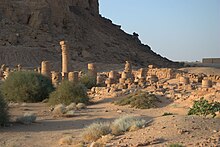Temple of Amun from Jebel Barkal

The Temple of Amun from Mount Barkal (referred to as B.500 in the specialist literature ) was the most important and largest temple building in the Egyptian style within the ancient city of Napata in Nubia . The temple dedicated to Amun was started as a small chapel at the foot of Mount Barkal in the Egyptian New Kingdom . Especially from about 750-300 BC. When Napata was the capital of the Kushite Empire , the temple was the religious center of Nubia. He was referred to as Ipet-sut of Napata , so Karnak of Napata .
history
There are indications that the temple of Thutmose III. Founded. A large stele that was found in this place comes from this ruler. The oldest part still standing today comes from King Haremhab or Sethos I (approx. 1290 to 1279 BC). This building was extended by Ramses II (approx. 1298 BC to 1213 BC). It was a small temple with a first pylon and a courtyard with ten columns . It followed behind a second pylon, a second courtyard, probably without columns, behind which there were three chapels. There were three other chapels to the side.
Pije (approx. 746 - 715/713) expanded this comparatively small temple approx. 450 years later. This was done in three steps. First the old temple was reinforced by a wall and received another small portico (520). As a second step, a large hall with a total of 50 columns was built (502). Only the columns, foundation walls and entrances were made of sandstone, the remaining walls of unfired bricks. Finally, Pije built a large courtyard (501), which was also decorated with columns. The courtyard and the portico each had their own pylon. The whole temple complex was now over 150 meters long. Only remains of the temple decoration have survived. The great court showed military scenes connected with the conquest of the ruler of Egypt. They are to be understood as a supplement to his stele, which describes this conquest in detail and which was found here in situ in 1862. This also proves that the courtyard was built after the 21st year of Pije's reign, the year he invaded Egypt.
In the years that followed, the temple was not significantly expanded, but many rulers erected steles , decorated walls or erected statues here . Taharqa erected 10 colossal figures here, the later rulers, up to Aspelta, followed this example. Tanotamun set up a small barge sanctuary in the portico. The large steles of Pije and Harsijotef were found in the first courtyard . Another important stele excavated here belongs to the Aspelta. The stele of Nastasen probably originally came from here, even if it was excavated in Old Dunqula . Acharites are represented here by a statue, Aktisanes by a decorated block. The fact that the rulers of the Meroitic period are almost completely absent from the temple indicates their lesser interest in this temple and in Napata in general. During the Roman campaign under Emperor Augustus in 25/24 BC. The temple was finally destroyed. The last major construction work probably took place under Natakamani , who had his name attached to the temple and certainly undone the Roman devastation. He mainly restored the first pylon, but also had other parts of the temple built.
Especially at the time of the Napatan Empire, the temple was of great importance for the Kushite kingdom. Although the rulers had their capital in Meroe early on , the accession to power began with a coronation journey, which first of all led to the Temple of Amun on Mount Barkal. Here the king went into the holy of holies, where the kingship was confirmed to him by the divine side at the king's oracle .
Current condition
The building is comparatively poorly preserved today. Most of the foundation walls are still standing, so that you can get a good impression of the plan, but the remaining walls are far away, so that most of the temple reliefs have been lost. Four rams and fragments of a fifth are placed in front of the entrance. Originally six rams were placed in front of the outer pylon, all of which presumably came from the temple of Soleb . Since 2003, the temple is situated, along with other buildings in the historic city of Napata and others in the region on the UNESCO list of world cultural heritage .
literature
- Dows Dunham : The Barkal Temples. Excavated by George Andrew Reisner . Museum of Fine Arts, Boston MA 1970.
- Timothy Kendall: Excavations at Gebel Barkal, 1996. Report of the Museum of Fine Arts, Boston, Sudan Mission . In: Kush . tape 17 , 1997, ISSN 0075-7349 , pp. 320-354 .
Web links
- Entry in the UNESCO World Heritage List (English) (French)
- Timothy Kendall: Jebel Barkal - History and Archeology of Ancient Napata . (English) On: jebelbarkal.org ; last accessed on December 5, 2013.
- Timothy Kendall: Napatan Temples: A Case Study from Gebel Barkal. ( MS Word ; 430 kB)
Coordinates: 18 ° 32 ′ 6.5 ″ N , 31 ° 49 ′ 50 ″ E




